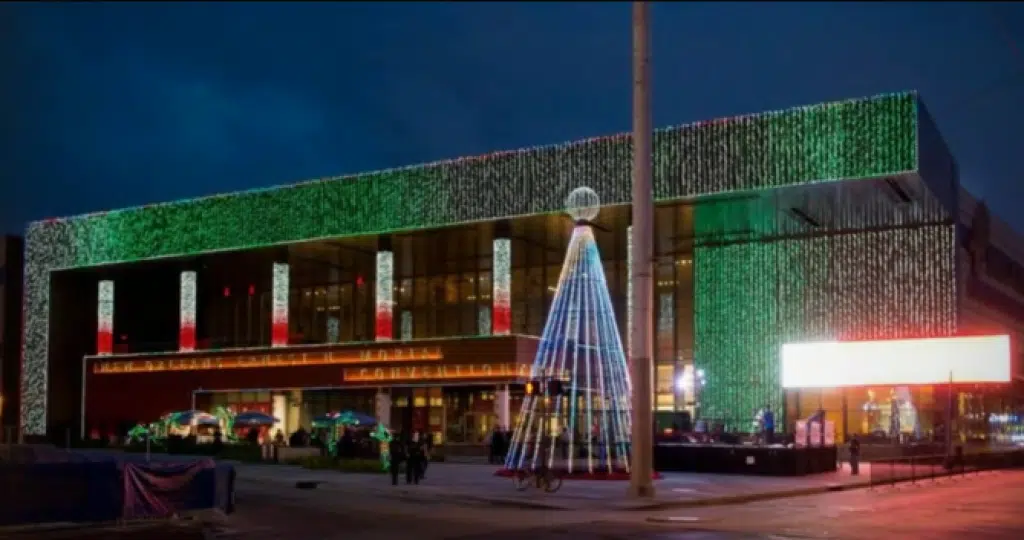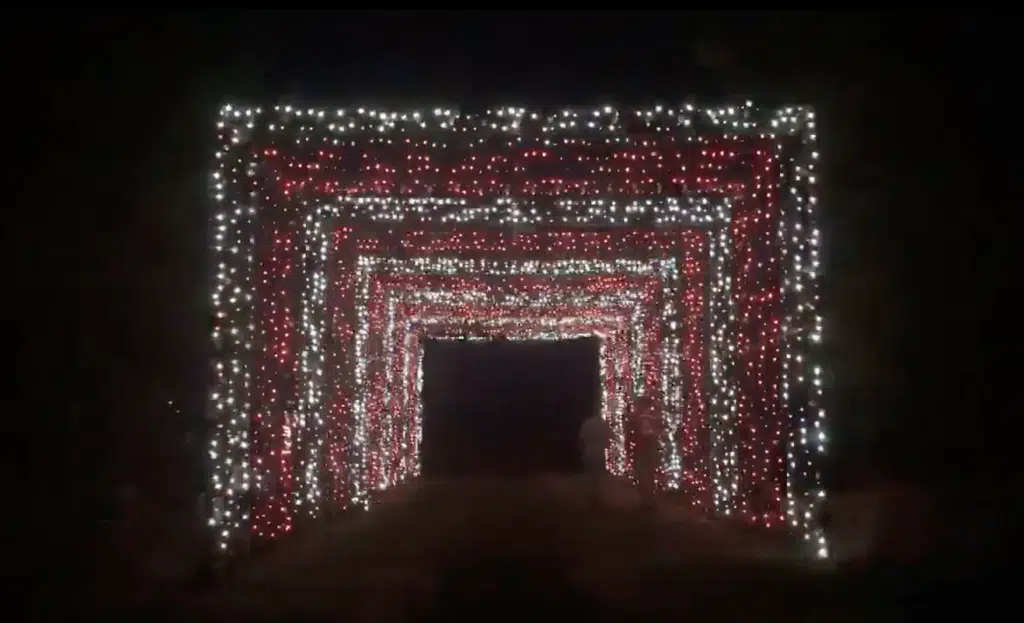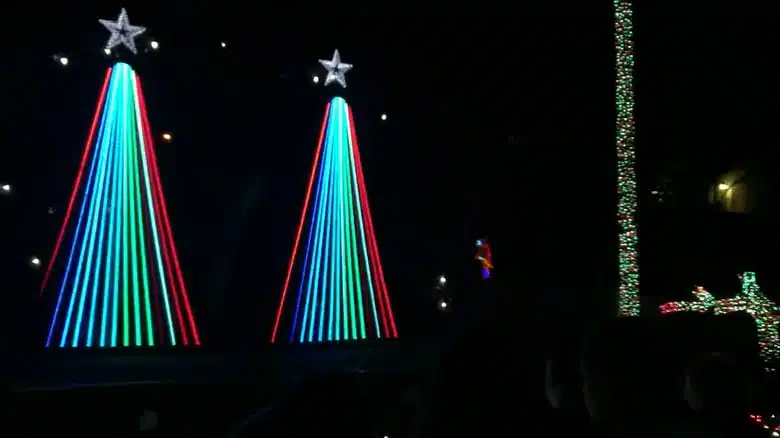Planning holiday lighting installations might be off the average homeowner’s radar for several more months—but for those in the commercial holiday lighting industry, projects are already in the planning phase. We talked to Darren Vader of Lumyn Immersive Media about the challenges and trends facing the holiday lighting and installation industry. Darren is the founder of The Christmas Light Emporium and Extreme Lightscapes, and has years of experience in the holiday installation industry.
What do your companies do, and is it possible to survive year-round in the holiday lighting industry?
This depends on what aspect of the season lighting industry a company is involved in. I see the market as having basically three top level segments: residential services, commercial services and retail/wholesale/commercial product sales.
My companies are involved in technology design and consulting for commercial projects and retail/wholesale product sales. I focus heavily on creating the highest perceived value possible. This allows me to design higher-end displays, pieces and light shows using the highest quality components available, while often implementing technology that is light years ahead of others in the market. All of these things mean I have a longer sales cycle—way longer than those who focus on residential and a good bit longer that those who only focus on commercial installation. So for me, it is absolutely a year-round focus. I spend the first half of the year selling new projects and the second half of the year doing onsite consulting/installation and managing our retail operation.
I would say that most companies involved in the seasonal lighting industry are more focused on what I call “right-now revenue’” rather than on providing long-term value for their customers.
For residential services, we are chiefly talking about Christmas light installers. It is not common to see a full time, year-round business with no other revenue stream. The most successful residential installers will have a few key staff that are full time/year-round and a vastly higher number of staff that are seasonal only. They also tend to pad revenue with other services such as landscaping or landscape lighting. I always tell my friends in the residential space who are successful that it’s not their skill at light installation that makes them good at what they do—it’s the fact that they are masters of logistics.
I would say that most companies involved in the seasonal lighting industry are more focused on what I call “right-now revenue’” rather than on providing long-term value for their customers. This is especially true in the residential holiday lighting installation market where a huge majority of service providers are small teams just trying to monetize on a season-by-season basis, and do not run full-time seasonal lighting operations. There are a lot of larger, successful companies in this space, but there are far more who are 1—4 person, seasonal-only operations just looking for “right-now revenue.”

Extreme Lightscapes: New Orleans Christmas in the District
Commercial service providers typically are able to command a higher price point for their services because it requires an advanced set of skills and new logistical challenges. The venues are almost always much larger. The installation time, equipment and logistics of working in public spaces are far more complex than in the residential space. I would say that a majority of companies specializing in large commercial installations are likely to be full-time, year-round operations even if with a limited staff. This is the segment within which technology specialists such as myself and my companies exist. Technology services and consulting for complex lighting installations is an underserved niche market that requires a very unique combination of right-brain/left-brain thinking.
Retail/Wholesale/Commercial Product Sales: this is where a good bit of the real magic happens. Manufacturers and retail/wholesale entities who have the foresight to create new and exciting products for use by commercial and residential installers are the ones who drive innovation in the seasonal lighting industry. Often they are being pushed by folks like myself and others in the residential and commercial services space who are constantly demanding new and innovative products. All of the larger commercial product companies are certainly year-round operations. There are a few retailers of seasonal lighting who are able to operate full-time as well. But most of them are supplementing with some level of marketing toward patio/landscape lighting, event lighting or even municipal and general lighting products.
Regardless of which segment of the seasonal lighting industry a company participates, I believe that whether or not a company can make a full time/year-round business out of it is chiefly based on their ability to create designs, services and products that are impressive enough to command a high-perceived value. You have to build a reputation as being one of the best in the industry nationally or even internationally in order to command top dollar and top margins, and afford to work on Christmas all year long!

Photo: Extreme Lightscapes
How do seasonal holiday installers survive in the off-season?
Residential installers who do not run a company full-time are very often firemen, policemen, landscapers or otherwise employed in an opposing seasonal field. Residential installation companies who are full time will almost always also offer landscape or landscape lighting services to keep some cash flow rolling during other parts of the year.
What are the biggest challenges facing holiday installers today?
As a business owner, I think the biggest challenges are:
- Increasing product costs from overseas manufacturers
- Difficulty in keeping up with changes in technology and its knowledge curve
- Maintaining the ability to create designs, services and products that are impressive enough to command a high-perceived value
How do you see those challenges being addressed?
Manufacturing of holiday lighting on the high end has somewhat shifted to Europe, but that makes the cost very high. I think that in the future we will see some of the larger European companies open manufacturing facilities in the U.S.. I already see some U.S. companies in the commercial product space who are taking European style and having similar designs produced in Asia at a much lower price point. When it comes to the basic components—lighting, technology and supplies – if costs of production continue to increase in Asia, I see the possibility of U.S. distributors moving production to places like Mexico and the Philippines or other areas where cost can be brought back down a bit.
Keeping up with technology will always be a challenge. It is a generational thing. Just like my generation was the first Internet generation, we are now getting “schooled” by our kids, who are the first social media generation. In a similar fashion, I was part of the first generation of seasonal lighting technologists. I am very often getting “schooled” by the next/younger generation of technologists who, for example, are fluent with and have pushed the limits of what can be achieved with RGB lighting and control systems. At some point I feel like we have to move beyond being hands on with it ourselves and focus more on the theoretical—coming up with visions, inventions and ideas that are superior to what exist right now—and then hire the next/younger generation to build out those visions! Much like the Apple, Steve Jobs approach to technology.
Interactivity and immersive environments and displays. This is the same mantra being chanted in every corner of all segments of the event production space.
Maintaining the ability to bring to market designs and technologies that have a high-perceived value, I think, is just a matter of never getting bored. You have to absolutely love seasonal lighting. When you stop loving it more than everyone else, you will stop caring about creating things with a high-perceived value. If you don’t value your ideas, neither will anyone else.

Extreme Lightscapes Tunnel
What current trends are you seeing in installation projects?
Interactivity and immersive environments and displays. This is the same mantra being chanted in every corner of all segments of the event production space. The human condition is so complex, and getting more so year by year, that people are becoming desensitized to what we have known as common visual and audio stimulants. The world is so audibly and visually “noisy” that we have to cut through all the mess by offering interactive displays, immersive environments and advanced sensory experiences in order to capture people’s attention, bring their minds into a peaceful zone (or a party zone, or a reflective zone, or whatever happens to be appropriate for the environment) and give them something important that will tell a story on behalf of the producer.
If it wasn’t for my focus on technology, I’d just be another miscellaneous commercial lighting installer.
When it comes to how: RGB RGB RGB RGB. European design. Video mapping—both using traditional projectors and more recently by using RGB pixel grids and feeding them video content. Sound, motion reactivity, physical interaction, etc.
What are the differences in the demands you get from commercial vs. residential clients?
I would say that commercial installers are being hit with all of the tending demand we just mentioned. They are being asked to execute these interactive and immersive visions within often very tight budgets. Residential installers I think have a completely different challenge. Residential buyers are notoriously “best price” shoppers without much regard to who the best person is for the job.
Up to how much do clients pay (residential vs. commercial) for their installations?
This is all over the map. I focus on commercial projects. My average project is probably around $100,000 with a huge range of $50,000-$1million, with a mean budget probably around $50,000-$75,000.
For residential installers, the range is also very wide. Most of the non-full-time, one-man operations are also wildly undercutting the full-time installers and and probably average around $200-$300 and focus on 1-story or smaller 2-story neighborhoods. At the same time, I know several full-time residential installation companies who have a $1,000 minimum per project and they are extremely successful. Their clients are typically wealthy neighborhoods and small commercial venues (small shopping centers, stand alone restaurants, etc).
Do you ever have clients request holiday installs that are also adaptable for year-round use?
Rarely. This is something that I am trying to educate my customers on. A seasonal display that is truly designed to bring out the feeling of the holidays is never going to be something you want left up all year long in its entirety. But we almost always are including components within those displays that most certainly could and should be considered for permanent, all-year use. This is especially true of some of the interactive displays and many components that use RGB lighting systems or projection. These systems are relatively easy to create new content for changing times of the year.

Extreme Lightscapes Installation at Dallas Zoo
What role does new technology play in your business?
Massive. It’s all I do. This is what makes my company unique. There are not many of us in the seasonal lighting business who only focus on new technology. This doesn’t mean that I don’t do anything else, but new technology is always what we lead with and it is what my companies are known for. There are only a small handful of others who approach seasonal lighting this way who are full-time operators. If it wasn’t for my focus on technology, I’d just be another miscellaneous commercial lighting installer.
Is interactivity a growing component of the holiday lighting install industry?
Absolutely. And not just with technology. One of the most popular types of display pieces I have included in my designs recently has been 3-dimensional pieces that people can walk through or touch. This year I am pushing these limits with the vision to bring to market solutions that are both 3-dimensional walk-through piece and immersive, multi-sensory experiences. I fully believe that this is where the market is heading. And there are a million different ways to bring this vision to fruition. I believe that the immersive movement will last for a while into the future.
What are some examples of interactive installations you’ve done?
Walk-through ornaments, stars, tunnels, light show tunnels, sound-to-light, Santa set built inside a light-show tree, next step—multi-sensory displays!
